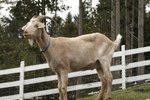
When you think of animals doing tricks, a goat is probably not the first animal that comes to mind. The truth is, goats are one of the most intelligent domesticated animals. But goats have individual personalities and temperaments, so some learn better than others. Whether you are trying to leash-train your goat, milk-stand-train him or train him to do a variety of entertaining tricks, the basic method is the same.
Start Young
Training goats goes best when you start young and spend regular time interacting with them. If your interaction's limited to providing food, watering and cleaning up the pen, the odds of your goats being receptive to training are not high. Spend time playing with them and petting them. Let them become comfortable with your presence and your touch before you jump in and try to teach them tricks. Bottle-raising kids allows the baby goats to bond with you, creating a greater connection. This is crucial for goats you want to eventually train.
Time and Patience
Goats can have off days, and they can be stubborn. While you might have plans for a training session, they might not. Begin slowly and keep training sessions short so as not to frustrate yourself or your goats. Never hit or yell at your goats during training. Reward your goats with treats when they do what you ask. Commercial goat treats are available to use for teaching tricks, but other good treats include corn chips, raisins, small carrots and some other fruits and vegetables.
Basic Training
Your goats need basic training before they can do tricks. Start with leash-training and milk-stand training. If you plan to take your goats places, such as shows, training them to walk on-leash will be helpful. Begin by letting them get used to having collars. Add a leash to one and give a gentle tug. Reward your goat with treats when he takes a few steps on the leash. Try walking each goat for a few minutes each day until it becomes a natural outing. While goats love to climb and jump on things, a milk stand is not one of the things they are eager to jump on. Coax your goats one at a time onto the stand with treats, and have food in the tray. Move slowly and don’t jump right into milking. Make the experience a pleasant one so your goats will be more likely to comply.
Fun Tricks
After they've had leash training and other basic training, goats can learn fun and entertaining tricks. Just like dogs, they can learn to sit, shake hands, jump through hoops, walk upright on hind legs or walk on a balance beam. To teach your goat to dance on her hind legs, choose the cue word "Walk" or "Dance." Hold a treat above her head while saying your cue word. As with training a dog, you'll want to move the treat from in front of her face in a straight line toward her tail so she's forced to look up and follow the treat. Raise it over hear head and behind until she lifts her front feet up. Praise her and give her the treat. Progress to making her take a few steps before receiving praise and treats. Use the same ideas to teach sitting and shaking hands.
Jumping and Beam Walking
Jumping through hoops or walking a beam are similar to dog agility trials, and you can use the same equipment for many of these tricks. To get your goat to jump over a bar or through a hoop, use the cue "Jump" and hold a treat on the other side. The advantage with goats is that they believe the best way to get to something is a straight line, making them more likely to go directly over the obstacle. The same holds true for a beam. Guide your goat up a ramp and let her watch as you place a treat at the other end and use a verbal cue to direct her to walk.
References
Photo Credits
-
John Foxx/Stockbyte/Getty Images
Writer Bio
Deborah Lundin is a professional writer with more than 20 years of experience in the medical field and as a small business owner. She studied medical science and sociology at Northern Illinois University. Her passions and interests include fitness, health, healthy eating, children and pets.




